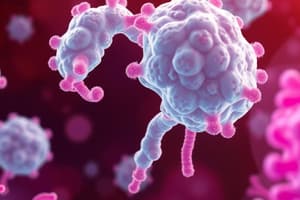Podcast
Questions and Answers
What are the characteristics of diphtheria caused by Corynebacterium diphtheriae?
What are the characteristics of diphtheria caused by Corynebacterium diphtheriae?
- Gastrointestinal illness with vomiting, diarrhea, and abdominal pain
- Neurological illness with paralysis and loss of sensation
- Upper respiratory tract illness with sore throat, low fever, and an adherent membrane on the tonsils, pharynx, and/or nasal cavity (correct)
- Lower respiratory tract illness with cough, fever, and chest pain
Which of the following best describes the morphology of Corynebacterium diphtheriae?
Which of the following best describes the morphology of Corynebacterium diphtheriae?
- Aerobic club-shape, gram positive, non-spore forming, non-motile bacteria (correct)
- Facultative anaerobic coccus, gram positive, spore-forming, non-motile bacteria
- Aerobic rod-shaped, gram negative, non-spore forming, motile bacteria
- Anaerobic spiral-shaped, gram negative, spore-forming, motile bacteria
Where are Corynebacteria commonly found in the human body?
Where are Corynebacteria commonly found in the human body?
- Genitourinary tract
- Oral cavity and intestines
- Skin and nares (correct)
- Lungs and bronchi
What is the causal agent of the disease diphtheria?
What is the causal agent of the disease diphtheria?
What toxic effects can be caused by the diphtheria toxin produced by C. diphtheriae?
What toxic effects can be caused by the diphtheria toxin produced by C. diphtheriae?
Flashcards are hidden until you start studying
Study Notes
Diphtheria Characteristics
- Diphtheria, caused by Corynebacterium diphtheriae, primarily affects the throat and upper respiratory tract.
- Symptoms include sore throat, fever, and malaise, often with the development of a pseudomembrane in the throat.
- Complications can involve myocarditis, peripheral neuropathy, and respiratory obstruction.
Morphology of Corynebacterium diphtheriae
- Corynebacterium diphtheriae appears as club-shaped (bacilli) and is often found in V or Y shapes under microscopic examination.
- It is gram-positive and exhibits palisade arrangement, which resembles Chinese letters in stained smears.
Common Locations of Corynebacteria in the Human Body
- Corynebacteria are commonly located in the skin, respiratory tract, and mucous membranes of healthy individuals.
- They are part of the normal microbiota but can become pathogenic under certain conditions.
Causal Agent of Diphtheria
- The disease diphtheria is caused by the bacterium Corynebacterium diphtheriae.
- The pathogen produces a potent exotoxin that leads to the characteristic symptoms and complications of the disease.
Toxic Effects of Diphtheria Toxin
- Diphtheria toxin inhibits protein synthesis in host cells, leading to cell death.
- It can cause damage to various tissues, particularly in the heart (myocarditis) and nervous system (neuropathy).
- The systemic effects can lead to severe complications, including heart failure and paralysis, if untreated.
Studying That Suits You
Use AI to generate personalized quizzes and flashcards to suit your learning preferences.




